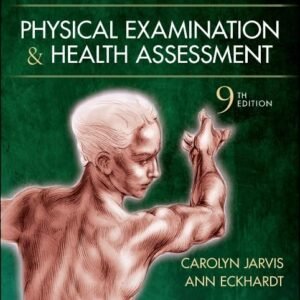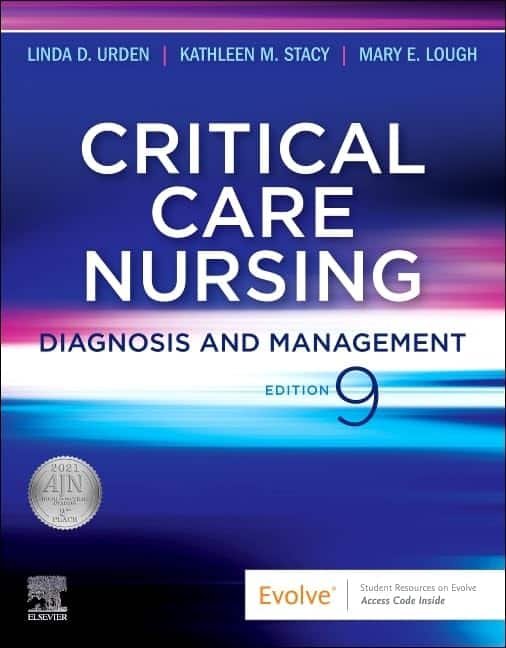Test Bank Critical Care Nursing: Diagnosis and Management, 9th Edition
$26.00 Original price was: $26.00.$23.00Current price is: $23.00.
Prepare for critical care nursing exams with Critical Care Nursing: Diagnosis and Management 9th Edition Test Bank by Test Bank for Critical Care Nursing 9th Edition | PDF n, Kathleen M. Stacy, and Mary E. Lough. Includes NCLEX-style questions and rationales.

Description
Test Bank for Critical Care Nursing (9ᵗʰ Edition)
Get ready to excel with this comprehensive test bank for critical care nursing, designed specifically for students and practitioners preparing for high-acuity environments. This PDF download complements the textbook Critical Care Nursing: Diagnosis and Management, 9ᵗʰ Edition, by Linda D. Urden & Kathleen M. Stacy, and is tailored for ICU exam prep, CCRN® / PCCN® readiness, and advanced clinical review.
Table of Contents
- UNIT 1: FOUNDATIONS OF CRITICAL CARE NURSING
- 1. Critical Care Nursing Practice
- 2. Ethical Issues
- 3. Legal Issues
- 4. Genetic Issues
- 5. Facilitating Care Transitions New title/focus!
- 6. Psychosocial and Spiritual Considerations New title/focus!
- 7. Nutrition Alterations and Management New title/focus!
- 8. Pain and Pain Management
- 9. Sedation, Agitation, and Delirium Management
- 10. Palliative and End-of-Life Care
- UNIT 2: CARDIOVASCULAR ALTERATIONS
- 11. Cardiovascular Anatomy and Physiology
- 12. Cardiovascular Clinical Assessment
- 13. Cardiovascular Diagnostic Procedures
- 14. Cardiovascular Disorders
- 15. Cardiovascular Therapeutic Management
- UNIT 3: PULMONARY ALTERATIONS
- 16. Pulmonary Anatomy and Physiology
- 17. Pulmonary Clinical Assessment
- 18. Pulmonary Diagnostic Procedures
- 19. Pulmonary Disorders
- 20. Pulmonary Therapeutic Management
- UNIT 4: NEUROLOGIC ALTERATIONS
- 21. Neurologic Anatomy and Physiology
- 22. Neurologic Clinical Assessment and Diagnostic Procedures
- 23. Neurologic Disorders and Therapeutic Management
- UNIT 5: KIDNEY ALTERATIONS
- 24. Kidney Anatomy and Physiology
- 25. Kidney Clinical Assessment and Diagnostic Procedures
- 26. Kidney Disorders and Therapeutic Management
- UNIT 6: GASTROINTESTINAL ALTERATIONS
- 27. Gastrointestinal Anatomy and Physiology
- 28. Gastrointestinal Clinical Assessment and Diagnostic Procedures
- 29. Gastrointestinal Disorders and Therapeutic Management
- UNIT 7: ENDOCRINE ALTERATIONS
- 30. Endocrine Anatomy and Physiology
- 31. Endocrine Clinical Assessment and Diagnostic Procedures
- 32. Endocrine Disorders and Therapeutic Management
- UNIT 8: MULTISYSTEM ALTERATIONS
- 33. Trauma
- 34. Shock, Sepsis, and Multiple Organ Dysfunction Syndrome
- 35. Burns
- 36. Organ Donation and Transplantation
- 37. Hematologic and Oncologic Emergencies
- UNIT 9: SPECIAL POPULATIONS
- 38. The Obstetric Patient
- 39. The Pediatric Patient
- 40. The Older Adult Patient
Highlights & Key Features
- Complete chapter-by-chapter question sets aligned to every unit and chapter listed above.
- Multiple-choice, scenario/case-study formats, clinical-assessment-based questions.
- Detailed answers & rationales included to promote deep understanding and exam readiness.
- Designed for critical care nursing scenarios including ICU, adult & special populations.
- Ideal for students, postgraduate nurses, and professionals preparing for advanced certifications.
Sample Questions
- MULTIPLE CHOICE
1. An elderly patient is in a motor vehicle accident and sustains a significant internal hemorrhage. The nurse knows the patient is at risk for developing what type of acute kidney injury (AKI)?
a. Intrinsic
b. Postrenal
c. Prerenal
d. Intrarenal
ANS: C
Any condition that decreases blood flow, blood pressure, or kidney perfusion before arterial blood reaches the renal artery that supplies the kidney may be anatomically described as prerenal acute kidney injury (AKI). When arterial hypoperfusion caused by low cardiac output, hemorrhage, vasodilation, thrombosis, or other cause reduces the blood flow to the kidney, glomerular filtration decreases, and consequently urine output decreases. Any condition that produces an ischemic or toxic insult directly at parenchymal nephron tissue places the patient at risk for development of intrarenal AKI. Any obstruction that hinders the flow of urine from beyond the kidney through the remainder of the urinary tract may lead to postrenal AKI.
PTS: 1 DIF: Cognitive Level: Applying REF: p. 632 | Box 26-2 OBJ: Nursing Process Step: Diagnosis TOP: Renal MSC: NCLEX: Physiologic Integrity - MULTIPLE CHOICE
2. A patient has developed acute kidney injury (AKI) secondary to cardiogenic shock. Which laboratory value would the nurse find helpful in evaluating patient’s renal status?
a. Serum sodium
b. Serum creatinine
c. Serum potassium
d. Urine potassium
ANS: B
Serum creatinine is the most reliable predictor of kidney function. In the acutely ill patient, small changes in the serum creatinine level and urine output may signal important declines in the glomerular filtration rate and kidney function.
PTS: 1 DIF: Cognitive Level: Applying REF: p. 631 | Table 26-1 OBJ: Nursing Process Step: Assessment TOP: Renal MSC: NCLEX: Physiologic Integrity - MULTIPLE CHOICE
3. A patient has developed acute kidney injury (AKI) secondary to hemorrhage shock. Which intravenous solution would the nurse expect to be ordered for this patient?
a. Dextrose in water
b. Normal saline
c. Albumin
d. Lactated Ringer solution
ANS: B
Prerenal acute kidney injury (AKI) is caused by decreased perfusion and flow to the kidney. It is often associated with trauma, hemorrhage, hypotension, and major fluid losses. If contrast dye is used, aggressive fluid resuscitation with normal saline is recommended.
PTS: 1 DIF: Cognitive Level: Applying REF: p. 639 OBJ: Nursing Process Step: Intervention TOP: Renal MSC: NCLEX: Physiologic Integrity
Why This Test Bank Matters
High-acuity critical care nursing demands sharp clinical judgment, rapid decision-making, and mastery of detailed pathophysiology & interventions. This test bank helps you build those skills via realistic questions, rationales, and system-by-system coverage. Whether you’re preparing for NCLEX®-style questions, ICU unit review, or advanced certification (CCRN®, PCCN®), this is the resource made for success.
Who This Is For
– Nursing students specialising in critical care
– Registered nurses preparing for ICU certification or advanced roles
– Educators needing structured question sets for tutorials or group review
– Graduates seeking high-level exam prep for adult critical care settings
Frequently Asked Questions
What is included in the Test Bank for Safe Maternity & Pediatric Nursing Care, 3rd Edition?
This test bank contains multiple-choice questions aligned chapter by chapter with the textbook. It provides a useful resource for students and instructors to practice and review maternity & pediatric nursing care.
Is this test bank aligned with NCLEX preparation?
Yes. The questions are suitable for exam preparation and include formats similar to NCLEX-style questions.
Who authored the textbook this test bank supports?
The textbook is authored by Linda D. Urden, Kathleen M. Stacy, and Mary E. Lough
How do I access the file after purchase?
After you complete the purchase, you’ll receive a secure download link for a PDF file—typically available for immediate download.
Do the questions include answers and rationales?
Yes — this test bank includes full answers and detailed rationales for each question
Only logged in customers who have purchased this product may leave a review.
Related products
-
Sale!

Test bank for Physical Examination and Health Assessment, 9th Edition
$26.00Original price was: $26.00.$23.00Current price is: $23.00. Add to cart -
Sale!

Test Bank for Huether & McCance’s Understanding Pathophysiology, 2nd Canadian Edition
$26.00Original price was: $26.00.$23.00Current price is: $23.00. Add to cart -
Sale!

Test Bank for Advanced Practice Nursing: Essentials for Role Development, 5th Edition
$26.00Original price was: $26.00.$23.00Current price is: $23.00. Add to cart -
Sale!

Test Bank for Discovering the Life Span, 5th Edition by Robert S. Feldman
$26.00Original price was: $26.00.$23.00Current price is: $23.00. Add to cart


Reviews
There are no reviews yet.